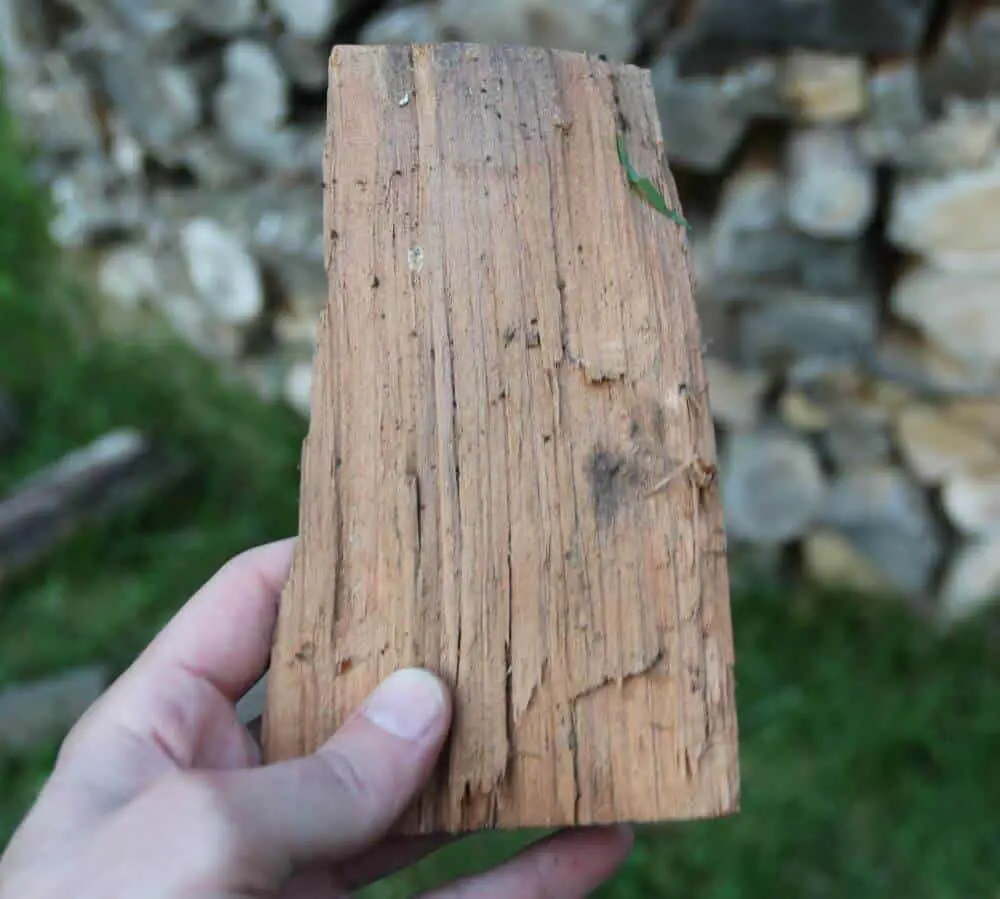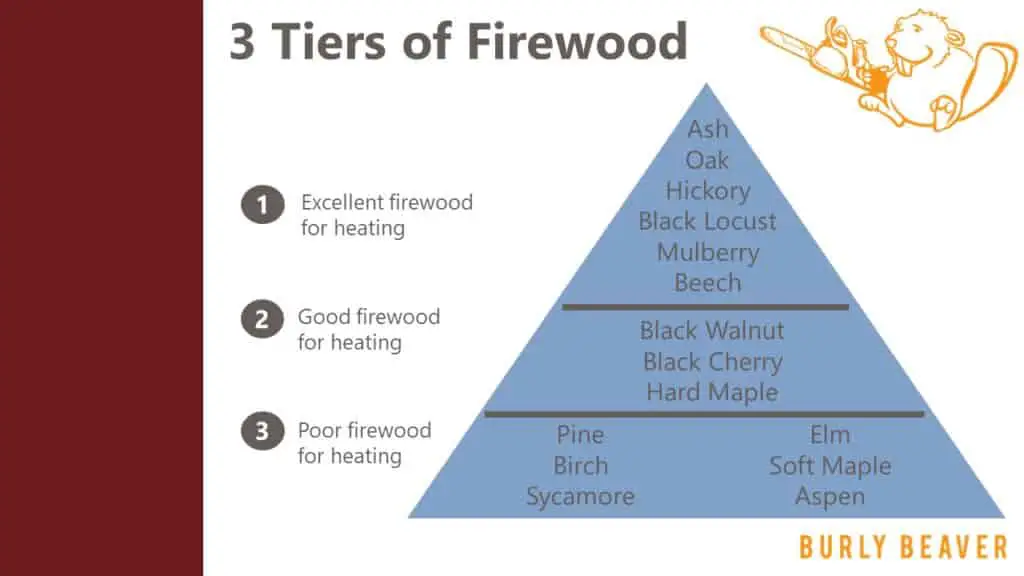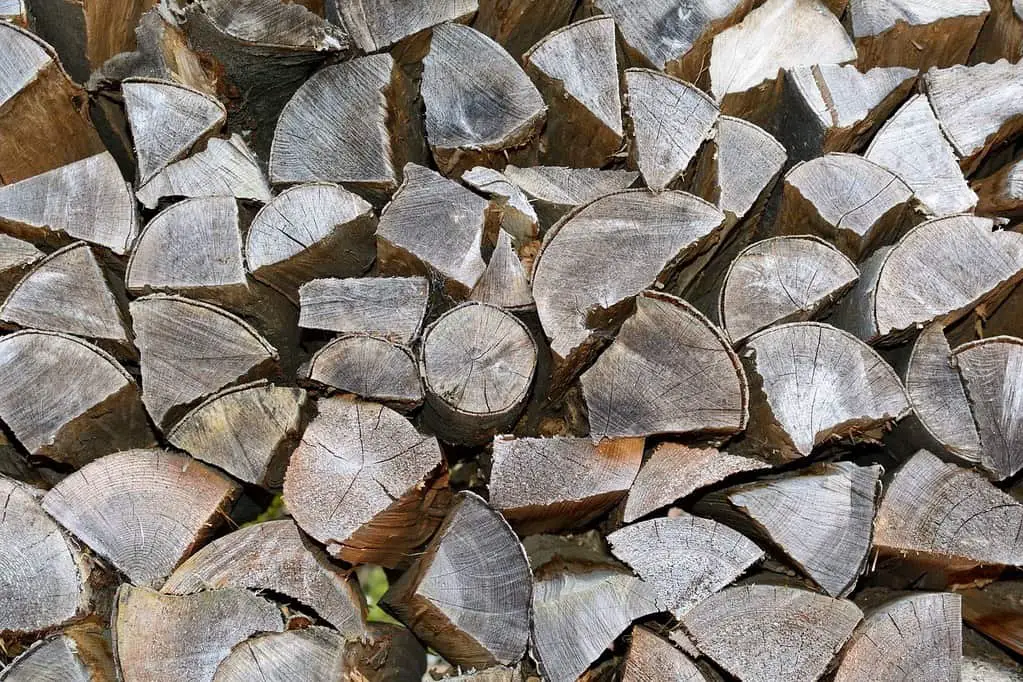
Wondering how Cherry will burn as firewood? There is a HUGE variety of wood types, and that can make it tough to know if a particular piece of firewood is any good.
We’ve compiled public data from university extension offices, and paired that with our own knowledge, to answer the most important questions about Cherry (also called Black Cherry) firewood.
Let’s start with the 10,000-foot view: Is Cherry good firewood?
Cherry is moderately good firewood. Cherry firewood is best known for the pleasant aroma it produces when burned. However, Cherry has a relatively low heat output of 20.4 million BTUs per cord and is not as good for heating compared to heavier woods like Hickory and Oak.
That’s the quick answer, but there’s a lot more to it than that. Below we’ll cover the characteristics you can use to compare Cherry to different types of common firewood.
Cherry vs. Other Firewood

To help you get an idea for how Cherry compares to other types of firewood, we’ve put together a graphic below, which provides a snapshot of some of the most common types of firewood in our area (in the Midwest USA), and they are divided into 3 levels of quality.
The top tier (top of the pyramid) is the absolute best firewood you can burn, whereas the bottom of the pyramid is the firewood that will still produce heat, but is not ideal because of low heat output, excessive smoke, difficulty splitting, or some other reason.
This ranking is not an arbitrary list, and it’s actually based primarily on data from several university extension offices.
If you’re not familiar with those, extension offices are typically associated with a university, and their role is to do research and provide services which help citizens better manage their land and natural resources. This includes guidance on the qualities of trees and firewood.
To learn more about the data sources, you can read the note below the image. Now, here it is!

The information in this image is based largely off of data from the following sources: Utah State University Forestry Extension, Oklahoma Cooperative Extension Service, University of Illinois Extension, University of Missouri Extension, South Dakota State University Extension. In addition, where there was missing data (only a few occasions), I’ve used my own experience to round out the data.
In the following section, we’re going to see how Cherry measures up against the 6 most important burn qualities for firewood. Let’s get to it!
The 6 Burn Qualities of Cherry

1. Heat Output vs Other Firewood
As we mentioned in the introduction, Cherry is somewhat mediocre when it comes to heat output. If your primary goal is to produce heat, then you’re going to be a lot better off with a denser hardwood.
For something like this, I think it’s really helpful to see some side-by-side numbers. So I made a chart 🙂
Check out the table below to see the BTU output and weight of 15 common firewood species’. Cherry is marked in bold text. (Note: data sources are mentioned beneath the infographic above).
Heat Output of Common Firewood
| Species | BTUs | Weight/Cord (lbs) |
| Black Locust | 29.3 | 4192 |
| Hickory | 28.5 | 4072 |
| Beech | 27.5 | 3760 |
| Oak (White) | 26.4 | 3776 |
| Mulberry | 25.8 | 3712 |
| Ash | 24.2 | 3472 |
| Maple (Hard) | 23.9 | 3408 |
| Black Walnut | 22.2 | 3192 |
| Pine (Southern Yellow) | 22 | 2936 |
| Birch | 20.8 | 2992 |
| Sycamore | 24.1 | 2872 |
| Black Cherry | 20.4 | 2928 |
| Elm | 20 | 2872 |
| Maple (Soft) | 19 | 2752 |
| Aspen | 18.2 | 2160 |
As you can see, Cherry is in the bottom 5 for heat output.
Heat output is definitely an important characteristic for firewood, but it’s not the only thing that matters.
Smoke output, sparking, the smell, and coaling are all important considerations for comparing different firewood choices as well.
In the next couple of sections, we’ll touch on more of the specific qualities of Cherry and continue comparing it to other types of firewood.
2. Amount of Smoke
Cherry produces very little smoke, especially when compared to Pine or Hard Maple, which are known to be big smoke producers.
It’s worth mentioning, that almost any wood will be VERY smokey if you burn it wet.
In addition to risks of creosote build-up (see #6 below), high smoke production is one of the reasons you should always make sure your firewood is properly dried before you burn it.
If you skip down to this section, you can learn more about seasoning firewood, and how you can accelerate the process.
3. Does it Spark?
Some types of firewood pop or spark quite powerfully, but Cherry is not one of them. Compared to some other firewoods, like Mulberry, Cherry produces minimal sparks
This is good news because wood that sparks heavily can create significant fire hazards (especially with open-air fires).
You obviously don’t want to start a forest fire (or a house fire), so it’s important to monitor any type of open-air fire, and also to know the qualities of the firewood you are burning.
4.Smell or Fragrance
Cherry is a big winner in this category, and its smell is a favorite for campfires. When it comes to aroma, the best choices mentioned in the list above are Cherry, Hickory, Pine, and Oak.
Each of these types of firewood have a very different smell, but Cherry’s is a rich and fruity smell. Since smell is so closely associated with flavor, that’s why Cherry is also used for barbeque and smoking meats.
If you find this talk of firewood fragrances interesting, then you should definitely check out our article on the 11 best smelling types of firewood.
5. Does it Produce Coals?
Another factor that is commonly used for rating firewood is “coaling”. When any kind of firewood burns it produces coals, and the quality of the coals produced has a big impact on how long (and how well) the fire will continue burning.
Firewood that is on the top of the list for BTU output, tend to have very good coaling properties. But Cherry actually does a really good job in this category as well.
Even though Cherry is not as dense as Hickory and Black Locust (for example), it still produces excellent coals which will significantly outperform woods like Pine, Birch, or Aspen.
6. Creosote Build-Up
If you’re using a fireplace or wood stove in your home, another important thing to consider is the maintenance of your chimney, and specifically preventing creosote build-up.
If you’ve not heard of creosote before, it’s a side product of burning wood, and it’s basically a black tar that is gradually deposited by wood smoke on the inside walls of a chimney.
Creosote isn’t a problem in small quantities, but if it gets built up, it can be quite dangerous. Build-up of creosote can reduce the ventilation of your chimney, and it’s also HIGHLY flammable, which can cause chimney fires.
To prevent creosote build-up, it’s important to properly maintain your stove and to have your chimney cleaned regularly.
In addition, you should only ever burn wood that is thoroughly seasoned (dried), because wet wood produces more creosote. Another big factor is the type of wood you’re burning.
In general, firewood that is very sappy will produce much more creosote build-up than firewood that is not as sappy.
Most hardwood firewood, including Cherry, have low sap levels and produce less creosote than very sappy firewood like Pine.
Speaking of Pine, it’s probably the worst type of wood when it comes to creosote build-up. Many people, including my family, completely avoid burning Pine in wood stoves as a result.
Burn Quality Overall Comparison

Alright, now that we’ve covered the 6 most important burning qualities for Cherry, let’s boil it down to the main highlights.
- Cherry has a relatively low BTU output compared to other common firewoods in our area, so it’s not the best choice if heating is your goal.
- Cherry is prized for its incredible smell and although aroma is a matter of preference, most people agree that Cherry is in the top tier.
- Cherry produces very good coals and even outperforms several heavier kinds of wood in this category, including Ash and Walnut.
- Cherry is very easy to split when dry and we didn’t mention this above, but Cherry is generally a very nice wood to work with.
Next, let’s touch briefly on identifying Cherry firewood, so you can be sure of the type of wood you’re dealing with.
Easiest Way to Identify Cherry Wood

I’ve got a piece of Cherry wood in my hand in the picture above, and what is the first thing you notice?
Well, without another piece of wood next to it, you might not get it right away. But the #1 easiest way to identify a piece of Cherry, is its color.
One of the tricky things about identifying firewood of any kind is that you often don’t have any leaves, and you sometimes don’t even have bark. And those are the two most common ways that people learn to identify trees.
But with Cherry, it’s pretty straightforward. The majority of the wood in our area has some variation of white and brown colors. But Cherry is a reddish-brown color (see image above for reference).
The other thing that sets Cherry apart, is that the red color is consistent throughout the wood. From the list of 15 common firewoods above, there are only two that have red-colored wood. Cherry and Mulberry.
But you can easily pick-out Mulberry because it has red heartwood and white sapwood. Which basically means it has an outer white ring and an inner red ring. Whereas Cherry is red through the heartwood and sapwood.
If you are a tree identification expert, then you may know of a more scientific approach, but for most people, using the color is going to work very well.
Seasoning Cherry Firewood
In general, firewood will take at least 6-8 months to fully season and for denser hardwoods, this process can take even longer. You should expect it to take 8 months or more to season Cherry firewood.
For wood to be “seasoned” basically just means that it’s thoroughly dried. Different types of firewood will require more (or less) time in order to dry-out, and you should always plan to burn firewood that is completely seasoned.

Exactly how long it will take depends on several factors, including the climate where you’re located (e.g. wood dries faster in Texas than in Oregon), and if you’ve properly split and stacked the wood.
In order to expedite the process, and to get your firewood seasoned as quickly as possible, use the following tips for fast drying:
5 Tips for Seasoning Firewood Fast:
1. Split the firewood
firewood dries WAY faster when it is split into pieces, rather than sitting in log-form. Think about it, when the wood is split more surface area is exposed to the wind and sunshine, which are the primary contributors to dry wood.
2. Elevate the firewood
You may do a double take here, because a lot of people don’t do this step due to the extra effort required. And I’ll admit, this isn’t absolutely essential, but if you put your stack of firewood up on some pallets or perpendicular planks, it will increase airflow beneath the firewood stack and will accelerate your drying time.
3. Stack the firewood
To optimize your drying time, you should stack your firewood neatly in a location that will maximize the amount of sunshine and airflow. For example, stack the wood away from buildings (out of the shade), and point the face of the stack (not the ends) towards the direction from which you get the most breeze.
4. Leave space between rows
if you make multiple stacks of firewood, each stack should be separated by at least a few inches for airflow. This will allow both stacks of wood to dry better.
5. Cover (optional)
If your wood pile is outside you can put a cover or tarp over the stack to drain any rain/snow. Just make sure that it doesn’t totally block airflow from the side of the stack, otherwise it will trap in moisture and make seasoning take longer.
if you want to learn more about seasoning firewood, you should take a look at this article.
Related Questions
What is the Best Firewood?
The best type of firewood for heating a home with a wood stove, is Black Locust or Hickory, due to the high heat output and long-lasting coals. For outdoor campfires, Pine or Cedar are better because they produce a pleasant fire that doesn’t burn too long.
Cherry Firewood vs Oak?
Oak is significantly better firewood than Cherry when it comes to heating a home. The heat output of Oak is among the highest for firewood at 26.4 million BTUs per cord, compared to 20.4 for Cherry. However, Cherry is a favorite for recreational campfires due to its excellent aroma.
